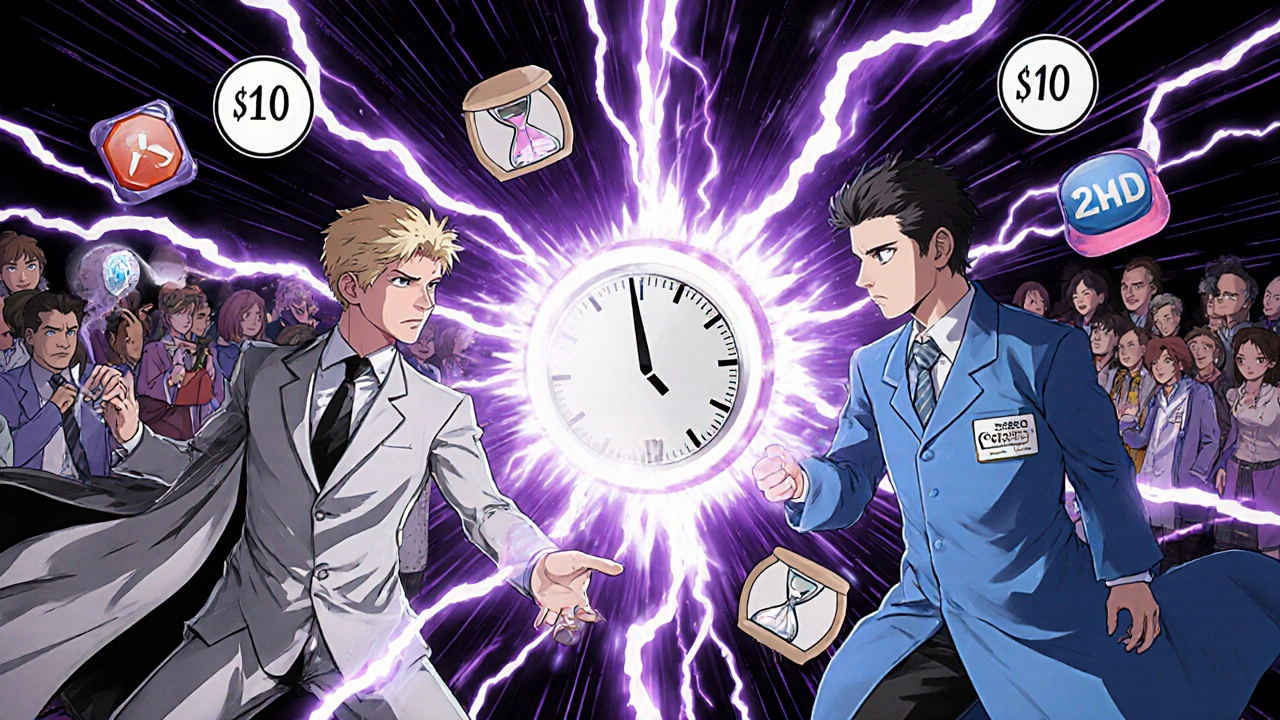If you’ve been prescribed Pariet (rabeprazole) for heartburn, GERD, or ulcers, you’re probably wondering if there’s a better, cheaper, or more effective option out there. You’re not alone. Millions of people use proton pump inhibitors (PPIs) every day, and many end up asking the same question: rabeprazole vs. the rest. Let’s cut through the noise and compare it directly with the most common alternatives - no fluff, just what matters.
What is Pariet (rabeprazole) really doing?
Pariet is the brand name for rabeprazole, a proton pump inhibitor. It works by blocking the tiny pumps in your stomach lining that produce acid. Less acid means less burning, less regurgitation, and faster healing of damaged tissue. It’s not a quick fix - it takes 1 to 4 days to reach full effect. But once it does, it keeps acid down for up to 24 hours.
It’s approved for:
- Gastroesophageal reflux disease (GERD)
- Active duodenal ulcers
- Active gastric ulcers
- Zollinger-Ellison syndrome
- Helicobacter pylori infection (when combined with antibiotics)
Most people take one 20 mg tablet daily. Some doctors start with 10 mg if symptoms are mild. The dose doesn’t usually go higher unless you have a rare condition like Zollinger-Ellison.
Rabeprazole vs. Omeprazole (Prilosec)
Omeprazole is the original PPI. It’s been around since the 1980s and is available as a generic - often under $5 a month. Rabeprazole came later, in the early 2000s. So what’s the difference?
Both reduce acid. But rabeprazole starts working faster. One study in the Journal of Clinical Gastroenterology showed rabeprazole raised stomach pH within 1 hour, while omeprazole took about 2 hours. That might not sound like much, but if you’re lying awake at night with burning, that first hour matters.
On the flip side, omeprazole has been studied more. Over 1,200 clinical trials. Rabeprazole? Around 200. That doesn’t mean it’s less safe - just less tested over decades. For most people, both work equally well. But if you’ve tried omeprazole and it didn’t help, switching to rabeprazole might.
Rabeprazole vs. Esomeprazole (Nexium)
Nexium is the brand name for esomeprazole, which is actually one half of omeprazole (the S-isomer). It was marketed as “better” and cost more - sometimes $200 a month before generics arrived.
Here’s the truth: a 2017 meta-analysis in Alimentary Pharmacology & Therapeutics found no meaningful difference in healing rates between rabeprazole and esomeprazole for GERD. Both healed about 85% of patients after 8 weeks.
But esomeprazole is metabolized slower in the liver. That means it sticks around longer. For some people, that means more consistent overnight acid control. If you wake up with acid reflux every morning, esomeprazole might give you a slight edge. But if you’re fine during the day and just need nighttime relief, rabeprazole works just as well - and costs less.
Rabeprazole vs. Lansoprazole (Prevacid)
Lansoprazole is another older PPI. It’s fast-acting, similar to rabeprazole. Some studies show it reduces acid even quicker - within 30 minutes. But its effect doesn’t last as long. One study found lansoprazole’s acid suppression dropped off after 16 hours, while rabeprazole held strong for 20+ hours.
If you’re taking lansoprazole twice a day, switching to rabeprazole once daily might simplify your routine. That’s a big deal for people managing multiple meds. Rabeprazole also has fewer drug interactions. Lansoprazole can interfere with clopidogrel (a blood thinner), which is a concern for heart patients. Rabeprazole doesn’t.

Rabeprazole vs. Pantoprazole (Protonix)
Pantoprazole is the most forgiving PPI when it comes to interactions. It’s often the go-to for people on multiple medications - especially those with kidney disease or on HIV drugs.
Rabeprazole and pantoprazole are similar in strength and duration. But pantoprazole is broken down differently in the liver. That means it’s safer if you have liver problems. If you’re on statins, antifungals, or antidepressants, pantoprazole is often the preferred choice.
But here’s the catch: pantoprazole takes longer to kick in. It can take 3-4 days to feel the full effect. Rabeprazole? You might notice relief by day 2.
So if you need fast relief and aren’t on complex meds, rabeprazole wins. If you’re on a cocktail of drugs or have liver issues, pantoprazole is the safer bet.
Over-the-counter options: Are they the same?
You can buy omeprazole, esomeprazole, and pantoprazole over the counter. Rabeprazole? Not in the U.S. or Canada. You need a prescription.
That doesn’t mean it’s stronger. It just means the FDA hasn’t approved it for OTC use - yet. Some countries, like Japan and Germany, sell rabeprazole without a prescription.
OTC PPIs are usually 10-20 mg doses, same as prescription strength. The only difference is how long you can take them. OTC labels say “take for 14 days, no more than once every 4 months.” That’s a safety rule - not because they’re dangerous. It’s because long-term use without medical oversight can hide serious conditions like stomach cancer or Barrett’s esophagus.
If you’re using OTC PPIs for more than 2 weeks, talk to your doctor. Don’t just keep buying more.
Side effects: What to watch for
All PPIs share the same risks:
- Headache (about 5% of users)
- Diarrhea or constipation
- Nausea
- Low magnesium (rare, but serious - can cause muscle cramps or irregular heartbeat)
- Increased risk of bone fractures with long-term use (over 1 year)
- Higher chance of C. diff infection (a severe gut bug)
There’s no clear evidence that rabeprazole causes more side effects than others. But because it’s newer, fewer long-term studies exist. That doesn’t mean it’s riskier - just that we’re still watching.
One thing to know: rabeprazole has a lower chance of causing vitamin B12 deficiency than omeprazole. That’s because it’s less likely to interfere with stomach acid needed to absorb B12 from food. If you’re vegetarian, over 60, or on metformin, this could matter.
Cost comparison: What you’ll actually pay
Here’s what a 30-day supply costs in Canada as of 2025:
| Medication | Brand Name | Generic Cost (CAD) | Notes |
|---|---|---|---|
| Rabeprazole | Pariet | $85-$110 | Prescription only |
| Omeprazole | Prilosec | $10-$15 | Available OTC |
| Esomeprazole | Nexium | $30-$50 | Generic widely available |
| Lansoprazole | Prevacid | $20-$35 | OTC and generic |
| Pantoprazole | Protonix | $25-$40 | Generic available |
Price isn’t everything - but it matters. If you’re paying $100 a month for Pariet and your symptoms are controlled, ask your doctor if switching to generic omeprazole is safe. Most people can. If you’re on a tight budget and have no complications, omeprazole is the smartest choice.

When to stick with rabeprazole
You should keep rabeprazole if:
- You’ve tried other PPIs and they didn’t work
- You need fast relief (within 24-48 hours)
- You’re not on other meds that interact badly with it
- Your doctor prescribed it for H. pylori treatment and it’s part of a proven combo
- You’re sensitive to the fillers in other PPIs (some people react to dyes or coatings)
Some patients report fewer side effects with rabeprazole than with omeprazole - especially stomach bloating and gas. It’s not proven in large trials, but it’s common enough in clinics that doctors keep it on the shelf.
When to switch
Consider switching if:
- You’re paying too much and your symptoms are mild
- You’re on blood thinners, antifungals, or HIV meds (ask about pantoprazole)
- You’ve been on PPIs for over a year without a follow-up
- You’re experiencing muscle cramps, fatigue, or irregular heartbeat (check magnesium levels)
- You’re trying to get off PPIs entirely and need a taper plan
Never stop cold turkey. Stopping PPIs suddenly can cause rebound acid hypersecretion - meaning your heartburn comes back worse than before. Work with your doctor to wean off slowly, usually over 2-4 weeks.
What about natural alternatives?
Some people turn to apple cider vinegar, ginger, or licorice root. There’s no solid proof they work like PPIs. A 2023 review in BMJ Supportive & Palliative Care found herbal remedies had no significant effect on acid reflux compared to placebo.
Lifestyle changes do help - but they’re not replacements:
- Don’t eat 3 hours before bed
- Elevate the head of your bed 6-8 inches
- Avoid alcohol, caffeine, chocolate, and spicy foods
- Loosen tight clothing
- Lose weight if you’re overweight
These won’t heal an ulcer or stop severe GERD - but they make PPIs work better. Use them as support, not substitutes.
Final take: Is rabeprazole worth it?
For most people, no - generic omeprazole is just as good and costs a fraction. But for some, rabeprazole is the sweet spot: faster relief, fewer interactions, and better tolerance.
If you’ve tried everything else and nothing worked, rabeprazole might be your answer. If you’re just starting out, ask your doctor for the cheapest option that fits your needs. And if you’re on PPIs long-term, get checked for nutrient deficiencies and bone health every year.
There’s no single best PPI. There’s only the one that works for you - without costing too much or causing trouble.
Is rabeprazole stronger than omeprazole?
Rabeprazole isn’t stronger - it’s just faster. Both reduce acid by about 90% after a few days. Rabeprazole starts working in 1 hour, omeprazole in 2. For most people, that small difference doesn’t change outcomes. But if you need quick relief, rabeprazole has an edge.
Can I switch from Pariet to generic omeprazole?
Yes, most people can. Studies show they’re equally effective for GERD and ulcers. Omeprazole is cheaper and available over the counter. Talk to your doctor first - especially if you’ve been on rabeprazole for a long time. You may need to taper slowly to avoid rebound acid.
Why is rabeprazole prescription-only in Canada?
The FDA and Health Canada haven’t approved rabeprazole for over-the-counter use, even though it’s sold OTC in some countries. That’s not because it’s unsafe - it’s because regulators want people to get checked for underlying conditions before using PPIs long-term. Omeprazole was approved for OTC use after decades of safety data. Rabeprazole hasn’t reached that level of long-term real-world evidence yet.
Does rabeprazole cause weight gain?
No direct link. Some people gain weight after starting PPIs because their reflux improves and they start eating more comfortably. But rabeprazole itself doesn’t cause weight gain. If you notice unexplained weight gain, talk to your doctor - it could signal another issue like fluid retention or thyroid problems.
How long should I take rabeprazole?
For ulcers or GERD, most people take it for 4-8 weeks. For maintenance, some take it long-term - but only under doctor supervision. If you’ve been on it for more than a year, ask about checking your magnesium, B12, and bone density. Never take it longer than needed.
If you’re unsure which PPI is right for you, bring a list of your meds and symptoms to your next appointment. Your doctor can match you with the safest, most affordable option - not just the one you’ve always been given.

10 Comments
Just switched from omeprazole to rabeprazole last month after my doc said my acid wasn’t fully under control. Honestly? First day felt like a miracle. No more 3am burning. And no weird bloating like I got with Prilosec. Still taking it, still feeling good.
Also, side note: I’m vegetarian and B12 has been a nightmare. My doc said rabeprazole might be gentler on absorption-turns out he was right. My levels stabilized after 2 months. Just saying.
Also, why is it prescription-only here? Like, it’s not magic. It’s just a chemical. 😅
LOL so you’re telling me I paid $100 a month for a drug that starts working 1 hour faster than the $10 generic? My bank account is crying.
Also, ‘rabeprazole has fewer interactions’? Bro, I’m on 7 meds. I don’t care if it’s ‘better’-I care if it doesn’t kill me. Pantoprazole all day, every day. Save the marketing fluff for the pharma reps.
OTC omeprazole saved my life. I’ve been on it for 5 years. No issues. Why make people pay more? 🤷♀️
It’s funny how we treat PPIs like they’re some kind of moral choice. ‘I took rabeprazole so I’m better than you.’
It’s just a proton pump inhibitor. Your stomach doesn’t care what brand is on the bottle. It just wants to stop burning.
Maybe the real question isn’t ‘which PPI?’ but ‘why am I producing so much acid in the first place?’
Have you tried sleeping on a wedge? Or not eating nachos at midnight? Just a thought.
Also, vitamin B12 deficiency isn’t a side effect of rabeprazole-it’s a side effect of being alive after 50. We all need supplements now. Deal with it.
Someone needs to write a book called ‘How Big Pharma Makes You Think You Need Expensive Drugs.’
Rabeprazole? That’s just omeprazole with a fancy coat and a $90 price tag. They didn’t invent anything new-they just repackaged the same molecule and called it ‘faster.’
And don’t get me started on ‘fewer interactions.’ That’s like saying ‘this poison has less arsenic.’ Still poison.
Also, ‘long-term use hides cancer’? Nah. Long-term use hides the fact that your doctor didn’t do a damn thing to fix your diet or stress levels. You’re not sick because of acid. You’re sick because you’re running on caffeine, sugar, and denial.
HOW DARE YOU SUGGEST I SWITCH FROM PARIET?! I’VE BEEN ON IT FOR 7 YEARS AND IT’S THE ONLY THING THAT’S KEPT ME ALIVE. I’M NOT A NUMBER, I’M A PERSON WHO HAS BEEN IN PAIN FOR DECADES. YOU DON’T KNOW WHAT I’VE BEEN THROUGH.
Also, omeprazole? That’s for people who don’t care about quality of life. I’ll pay $110 a month if it means I can eat dinner without crying. 😭
Let’s clarify a few things, because misinformation is rampant here.
First: All PPIs reduce acid by ~90% after 3–5 days. The differences in onset time (1hr vs. 2hr) are statistically significant but clinically marginal for most patients.
Second: The FDA’s OTC restriction on rabeprazole isn’t about safety-it’s about regulatory precedent. Omeprazole had 20+ years of post-marketing surveillance before being approved OTC. Rabeprazole hasn’t reached that threshold.
Third: Drug interactions are real. Lansoprazole inhibits CYP2C19, which affects clopidogrel activation. Rabeprazole has minimal CYP2C19 inhibition. That’s not marketing-it’s pharmacokinetics.
Fourth: If you’re on PPIs for >1 year, get your magnesium, B12, and bone density checked. Period.
Don’t switch because of price. Switch because your doctor says so. And if you’re self-medicating with OTC PPIs for more than 14 days? You’re not managing reflux-you’re masking a diagnosis.
Let’s be real: rabeprazole is the Ferrari of PPIs. Omeprazole? A 1998 Honda Civic with a busted AC.
Yeah, it gets you there. But do you want to arrive sweating and annoyed? Or do you want to glide in like you just rolled off the set of Top Gear?
And don’t give me that ‘it’s just chemistry’ nonsense. If you’ve ever had acid reflux at 2 a.m., you know it’s not just chemistry-it’s a war. And rabeprazole? It’s the general with the tactical napalm.
Also, ‘fewer interactions’? That’s code for ‘less likely to turn your liver into a parking lot for other drugs.’
And yes, I’m paying $110 a month. Because I’d rather pay for peace than spend my nights staring at the ceiling wondering if this is the night I choke on my own stomach.
Been on rabeprazole since 2020 after my ulcer didn’t heal with omeprazole. I swear, it’s like night and day. No more bloating, no more weird taste in my mouth. And I’m Irish-we drink, we eat, we don’t care. But this? This lets me live.
Also, I spelled ‘rabeprazole’ wrong three times before I got it right. My phone keeps autocorrecting it to ‘rabbit hole.’ Which, honestly? Kinda fits.
Look, I get it. You’re tired. You’re sick of feeling like your stomach is a volcano that just woke up mad. You just want to eat pizza without crying.
But here’s the thing: the best PPI is the one you’ll actually take. If rabeprazole makes you feel human again? Keep it. Even if it costs more.
But if you’re taking it because your doctor just handed you a script and said ‘take this’? That’s not care-that’s autopilot.
Ask yourself: Am I on this because I need it? Or because I’m scared to stop?
And if you’re on it for more than a year? Go get your B12 checked. Seriously. It’s a 10-minute blood test. It could save you from numb hands, brain fog, or worse.
Also-yes, sleep on a wedge. Yes, stop eating at midnight. Yes, lose the jeans that cut into your gut.
Medication helps. But lifestyle? That’s the real MVP.
And if you’re paying $110 for rabeprazole and you’re not on 5 other meds? You’re probably overpaying. Ask your pharmacist about the generic. They’ll tell you the truth.
And if you’re still in pain after all this? Go back to your doctor. Don’t just keep buying more pills. You deserve better than that.
Write a comment